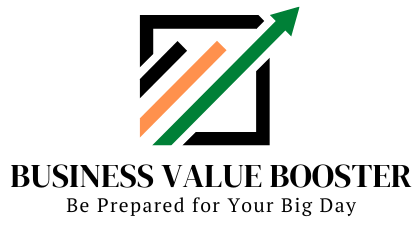Buyers value your business based on its performance to date and how it compares to other similar businesses. While that comparison includes a number of intangibles, such as location, lifestyle, and branding, those are just modifiers on a value based strictly on a reasonable multiple of the profitability. The better you can support your numbers, the closer to the top of the range you will get; if you can’t, you’ll see discounted offers far below that range. Here’s how to make your records work for you.

If your industry typically sells for 1.5-2.5 times net profit, these intangibles define where you fall in that range. They won’t shoot you to 5x.
Usually, Shark Tank isn’t relevant to most small businesses, but there is one critical point in common. They always ask for recent sales and profits. The song and dance in the pitch may get them interested in the first place, but in the end they base their company valuation almost entirely on the revenue and profit figures. So will your buyers.
It doesn’t take a great deal of effort to find out what typical industry multiples are, and the reality is that they are mostly about the same because it is actually a shorthand for the ROI on the purchase price if the net profits continue as they have.
That multiple means that any change in the apparent profits will be multiplied 2-3 times over in the business value, so it is critical that you (as the seller) are able to support your claims of revenue and profits. During the negotiation of the initial agreement, and later during due diligence, the buyer will try to poke holes in your numbers because a small discrepancy can have that multiplied effect on the overall value. If your business listing says $350,000/year net, your confidential disclosure package shows $210,000 based on some documentation, and once you get into the due diligence period the buyer finds the actual documentation that shows $125,000, don’t think that the buyer will just demand to renegotiate the price. You should be so lucky, Most will conclude that you are either dishonest or thoroughly incompetent, and they will walk away from the deal altogether rather than pay their accountants thousands of dollars to unravel your books.
In most cases, it won’t get that far. When the buyer and seller meet for a casual chat, the seller’s command of their numbers quickly becomes apparent. If the seller has provided only top-line numbers in the confidential package and then writes down some general categories of expense on a napkin (yes, I’ve seen that), the buyer will immediately assume that the books are either cooked or non-existent. Again, they will not waste their time or money in further discussions because they know that you have no idea what you are talking about or cannot be trusted to tell the truth. In any market the investor can find several other businesses that meet their needs and they will simply move on.
So what do good books and records look like?
Do you have to spend tens of thousands on a PA to rework them and spend much of your precious owner-manager time on bookkeeping instead of marketing, staff training, customer interaction or any of the other dozens of things that make your business run and grow?
Actually, “good” is pretty simple. They need to match each other and reality with sufficient clarity that a buyer can quickly see the consistency and decide there is no point wasting time and money digging further. That doesn’t necessarily require sophisticated systems, just processes that are good enough for the purpose and consistent with industry practices. How does that happen?
- Your point of sales system or your invoice register (depending on your business model) shows revenues consistent with your listing claims
- Your expenses are in general accord with your revenues (i.e. you’re not secretly dumping extra unrecorded money to cover the probable real expenses based on industry ratios)
- Your major categories of expense are largely accounted for in your register of invoices from your key suppliers, and those in turn supported by online or paper invoices
- Your profit and loss reports in major categories are close to the numbers shown in your point of sales system and your expense invoice register
- Your profit and loss reports can be reconciled to your tax returns. Those returns are considered the gold standard for documentation. Buyers understand that you have correctly chosen to minimize your taxes, but it should still be fairly easy to see how you got from one to the other. This is largely a matter of setting up certain sub-categories to make that translation easier. If your CPA has not already done this, your business broker can assist in recasting the financials to recover the true net income (“seller discretionary earnings”) on which the sale value rests.
- Your taxes are filed correctly and promptly (or at least legally). Even though your buyer may be planning an asset sale in which theoretically they would not be a party to any dispute you might have it the IRS, that’s a group for whom theory and logic are not always necessary. If your business is in trouble with them, get that resolved before you take it to market.
- Your corporate entity is in good standing with the state and your local business license and associated taxes are up to date. Buyers will not write checks to an entity that can’t even get this right; it’s an invitation to future problems because it places the ownership of the assets in doubt.
Yes, there are many other questions a buyer may ask during the due diligence phase. If you’re able to answer this set, and support your answer with documents that are in the file, you will pass most buyers’ credibility tests and establish good faith. In that case, if there is a question you had not foreseen, the buyer will give you time to come up with the answer or listen to your explanations. Yes, you may have to accept a little negotiation, but it will be between people who are treating each other as respected professionals; without confidence in your basic numbers, every issue the buyer finds will be treated as a red-flag that good faith, the sale will simply dissolve.
This may not require an elaborate accounting system. It’s possible, if it is appropriate for your type of business, to have thorough, transparent books using an Excel workbook, the business’ bank account statements, and a log of supplier invoices. And tax returns.
May we help you get more profitable, reduce risk and increase value?
Pick your own timeslot for a no-cost, no-strings 30-minute appointment at a time of your convenience by using our calendar.
Looking forward to learning more about your business situation!

